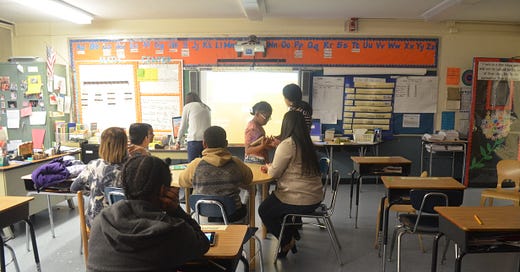Over dinner last weekend, I asked a friend, who teaches middle school in a middle class community in Westchester, whether schools were back to normal yet. She rolled her eyes and shook her head. Between staffing problems, quarantines, mask rules, students who never recovered from 18-month of remote education, and illnesses, her school was definitely not normal, she said.
Parents and teachers alike are telling the same story. The doors of the schools may be open, but inside there is chaos, exhaustion, sadness, and very, very little learning.
Full-time teachers aren’t quitting — yet — but areas that have always been hard to staff, like ELL, special education, and STEM, are struggling more than ever. The lack of low wage substitutes, aides, and bus drivers are the real problem. If teachers are absent, because they’re sick or in quarantine, someone has to watch the students. If there are not enough subs, then other teachers have to cover those classes, which uses up the prep time for their own classes.
Our school district sent out the SOS to parents to become substitute teachers. Because I’m a vocal critic of public education’s response to remote education, I decided to counter that criticism with a positive act and apply for a substitute license. I’m still several steps away from getting the license, because it takes two months, $225, fingerprints, a TB test, and piles of forms in my state to get a substitute license. All that for $115 per day in my district. An issue with the State’s education website held up the process for several days, because New Jersey’s Department of Education only works in the office two days per week. In this time of crisis, red tape, incompetence, and low wages drags the system down further.
Masks, too, have a real hinderance to the return to normal, especially for younger kids and kids with special needs. For a long time, those who pointed to problems with masking small children were written off as lunatics, but the public mood has swung the other way.
It was amazing to watch the speed at which masks became the lead story in every major newspaper this week. One of my tweets on masks went viral. I wrote more about masks in schools on the blog here. I pointed to teachers who hate masks, too. Writers in The Atlantic and the New York Times suddenly came out against masks in schools. It’s whip-lash!
Major media has been been criminally negligent in dealing with the education crisis and the impact on children. And don’t think that people don’t notice. Wide swaths of our country truly believe that those sources are “fake news,” so this negligence feeds that narrative. The real story is that major media neglected this story because education and parenting issues has always been “the rookie beat” at those venues and never taken very seriously by senior editors. Huge stories about kids and families went unreported, because the news industry has always seen education stories as fun fluff. It’s also true that the response to covid has always been more political than rational, and the media got caught up in that mess. So sad.
But major media is paying attention right now. Earlier in the week, 3 out of the 10 top stories in The Atlantic were about schools and children and were critical about the status quo. In the New York Times, Michelle Goldberg, who wrote a glowing story about Randi Weingarten not long ago, wrote a piece about ending masks in schools this week. Michael Barbaro, the voice of the New York Times’ podcast, The Daily, has been one of the most staunch defenders of closed schools and union policies, but this week, he acknowledged that the studies show that kids aren’t faring well right now. David Leonhardt pointed out in his newsletter this week that the majority Democrats and Republicans alike are worried about children’s learning and mental health, because of remote education. (Why is this not the lead in this story?)
What should we do about all this? Kids need fixing. Schools need fixing. And not just because the Democrats are going to get destroyed in the midterms over this issue. Without a fix, we’re dooming a generation of children to illiteracy and low income jobs and all the social woes that come from having few economic options.
Yes, the federal government gave billions to the schools to deal with COVID emergencies. But a whole lot of that money was spent on new ventilations systems, masks, professional development for teachers (more money for unregulated consultants! woot!), and other stuff that might have been needed at the moment but didn’t directly help kids.
My 19-year old son with autism, is still in the public school system. He has not benefited from one cent of that federal education money, despite the fact that he desperately needs help to deal with social skill and academic regression from remote education. Like every special education student, he needs tutoring and new after-school programs, but hasn’t received any of that help.
Short term vouchers for tutoring, social activities, and wellness programs should go directly to the students to be spent at either at their public school or at approved private programs. Student need to recover what was lost, and I don’t have time to get into a debate about vouchers. If a Kumon Center can tutor kids and the public school can’t handle it, pay Kumon to do the job.
And at the same time, we have to work harder than ever to get schools back to normal with hiring bonuses for STEM and special education teachers, better pay and benefits for substitute teachers, better supports in-schools for students with behavioral or emotional needs, and a place for parents at the decision-making table.





